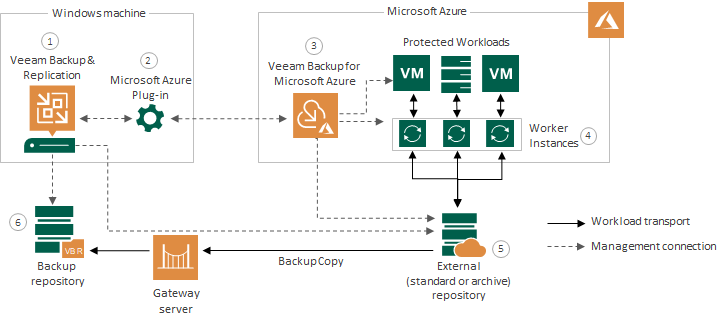 This is an archive version of the document. To get the most up-to-date information, see the current version.
This is an archive version of the document. To get the most up-to-date information, see the current version.Architecture Overview
If you have Microsoft Azure Plug-in for Veeam Backup & Replication installed on a backup server, the backup infrastructure includes the following components:
- Backup server — is a Windows-based physical or virtual machine on which Veeam Backup & Replication is installed. It is the core component of the backup infrastructure. For more information, see the Veeam Backup & Replication User Guide, section Backup Server.
- Azure Plug-in for Veeam Backup & Replication — is an architecture component that enables integration between Veeam Backup & Replication and Veeam Backup for Microsoft Azure.
- Veeam Backup for Microsoft Azure appliances — Linux-based VM instances where Veeam Backup for Microsoft Azure is installed. The appliances perform backup and recovery tasks, control backup policy scheduling, generate daily reports and email notifications. For more information, see the Veeam Backup for Microsoft Azure User Guide, section Architecture Overview.
- Worker instances — temporary Linux-based VM instances that are created by Veeam Backup for Microsoft Azure to perform backup and restore operations. Worker instances process backup workload and distribute backup traffic when transferring data to and from repositories. For more information, see the Veeam Backup for Microsoft Azure User Guide, section Architecture Overview.
- Standard and archive repositories — folders created in blob containers where Veeam Backup for Microsoft Azure stores backups of protected Azure VMs and SQL databases. For more information, see section Managing Repositories.
- Additional repositories and tape devices — any repositories where Veeam Backup & Replication keeps and stores copies of Azure VMs backups. For more information, see the Veeam Backup & Replication User Guide, sections Backup Repository and Machines Backup to Tape.
- Gateway servers — auxiliary backup infrastructure components that provide access from the backup server to repositories. By default, the role of a gateway server is assigned to the backup server.
Gateway servers cache data when you copy backups and restore application items, which helps you decrease the amount of traffic being sent over the network and reduce data transfer costs. For more information on caching data, see the Veeam Backup & Replication User Guide, section Cache.
